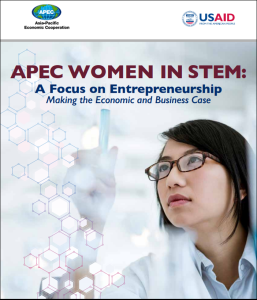- March 1, 2019
- Report
Support for women entrepreneurs in STEM (Science, Technology, Engineering and Math) can lead to job growth and higher returns for investors.
This report, authored by Nathan and funded by USAID and U.S. Department of State as part of the US-APEC Technical Assistance to Advance Regional Integration (US-ATAARI) project, is a follow-up report to the November 2016 publication APEC Women in STEM: A Framework for Dialogue, Learning and Action.
The report looks at women’s STEM entrepreneurship in the United States, given that data availability and metrics on women’s STEM entrepreneurship, or women’s entrepreneurship overall, are not consistent across all 21 APEC economies. The authors employ regression analysis to understand the broader economic impact, and bring together several relevant case studies.
Key findings include:
- Of all STEM jobs in the U.S. workforce, women hold less than one-quarter (24 percent) of STEM jobs.
- In STEM fields, women are more likely to launch businesses providing research and consulting services, which may be less scalable than STEM-based manufacturing industries like semiconductor, aerospace, or communications equipment.
- Some key constraints for women entrepreneurs include access to educational opportunities, skills, networks, mentors, role models, and access to capital and markets.
Kauffman Firm survey data shows a clear business case for investing in enterprises with at least one female owner. Businesses that fit this criterion generate more revenues, profits, and jobs than their all-male owned counterparts. - The authors’ analysis using Kauffman data indicates that compared to wholly male-owned firms, high tech firms with at least one female owner in a sample set have, on average, US$60,257 more in annual revenue and $46,471 more in annual profit.
- Based on analysis by this report’s authors of data from 5,000 multi-owner, high technology firms tracked by Kauffman, the U.S. can, (a) potentially add an additional 1,886 more jobs for this set of firms and (b) increase their total revenues by more than $145 million annually, if at least one woman is represented in the ownership.
- According to the Boston Consulting Group’s study of start-ups, female founders generate more revenue than their male counterparts despite systemic lack of access to equal amounts of capital: for every dollar raised, they generate 78 cents in revenue, compared to 31 cents for male-run start-ups. (Abouzahr et al. 2018).
- First Round Capital’s research shows that among their portfolio of about 300 start-ups, firms with a woman cofounder performed 63 percent better, when measured by valuation (First Round Capital, 2015).
- A National Bureau of Economic Research 2018 analysis of highly skilled occupations in the US (in fields such as law, medicine, science, academia, and management) shows a positive relationship in the U.S. between diversity within companies and the value of goods and services produced (Gompers and Kovvali 2018).
- The underrepresentation of women in STEM fields—not only as students and researchers but also as innovators, leaders, and entrepreneurs — significantly hinders sustainable economic growth and prosperity throughout APEC economies including the U.S.


